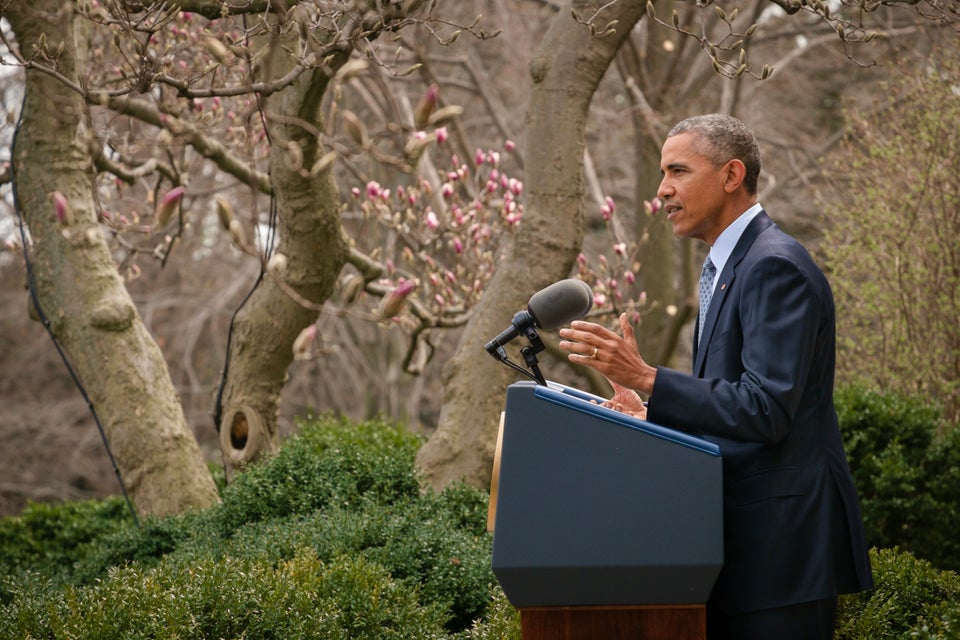
A 2012 satellite image of Parchin, an Iranian military complex and suspected site of past nuclear weapons activity.
WASHINGTON -- A veteran international nuclear official questioned the authenticity of a document The Associated Press relied upon for its controversial report that Iran would be allowed to inspect Parchin, a site suspected of hosting illicit nuclear activity over a decade ago. He said the document contains wrong terminology and other signs it may be fake.
Tariq Rauf, the former head of verification and security policy coordination at the International Atomic Energy Agency, told The Huffington Post that a document the AP described as a transcript of a draft agreement between Iran and the IAEA, published on Thursday, appears bogus, designed to undermine the real agreement and the broader nuclear pact negotiated between Iran, the U.S., and five world powers.
"In my personal view, this is not an authentic document," Rauf said. "Likely a crude attempt to hinder the JCPOA and the Road-map," he added, referring to the Iran nuclear deal, and the parallel agreement between Iran and the IAEA over an investigation into the possible military dimensions of Parchin, an Iranian military site thought to have been used for illicit nuclear weapons work prior to 2003.
The AP published an exclusive report on Wednesday alleging that the IAEA had tasked Iran with conducting inspections at Parchin.
The IAEA and the State Department implied in vaguely worded statements that the article's claims were inaccurate, but declined to comment specifically on the arrangement between Iran and the IAEA, citing confidentiality obligations.
The AP stood by its story, and on Thursday published what it said was a complete transcription of a draft of the document, outlining the parameters for the IAEA's probe into Parchin. The news agency cited two anonymous officials who it said confirmed that the draft version it published does not differ from the final version Iran and the IAEA agreed upon.
But Rauf said he immediately spotted signs that made him question the authenticity of the leaked document. Rauf, who worked for the IAEA from 2002 to 2011, now directs the Stockholm International Peace Research Institute's arms control program.
In an annotated version of the document, provided to HuffPost, Rauf describes 13 instances of incorrect terminology and practices that are inconsistent with IAEA safeguards methods.
Rauf suggested the leaked document may have surfaced in a way similar to the "Niger Letter," forged documents leaked prior to the 2003 U.S. invasion of Iraq that purported to show Iraqi President Saddam Hussein was purchasing 500 tons of uranium a year from Niger. Former President George W. Bush cited the findings in his 2003 State of the Union speech as evidence that Hussein was developing nuclear weapons.
Such a charge is explosive, considering the historical implications it invokes. Coming amid an increasingly tense debate over the passage of the larger Iran nuclear accord, it seems likely to only add additional layers of distrust to the debate.
"We have been transparent in our reporting," wrote John Daniszewski, the AP's senior managing editor for international news, in an emailed statement to HuffPost. "We obtained the draft from one source and authenticated it with two other sources who have firsthand knowledge of the final version. These two sources said the final version did not change substantively from the draft. No officials have disputed the accuracy of AP's report. We are confident of our reporting that this draft is authentic and contained these points."
In declining to comment on the document -- even if because of confidentiality agreements -- both the White House and the IAEA also give the impression that they don't believe the initial draft obtained by the AP is substantially different from the final version.
Even if the AP's Parchin document is an authentic representation of the IAEA agreement, however, interpreting what the language in it implies or means has been difficult.
AP's report on Wednesday said the wording of the agreement suggests the IAEA will be "barred from physically visiting the site." But the text of the document published Thursday says, "Iran will provide to the Agency ..." leaving it unclear whether officials from the nuclear watchdog agency will be allowed to enter Parchin. Iran has allowed IAEA officials into Parchin in the past.
The initial AP report included a quote from the leaked document that, taken out of context, implied that Iran would not use materials provided by the IAEA to collect samples from Parchin: "Activities will be carried out using Iran's authenticated equipment consistent with technical specifications provided by the agency." But in the full text of the arrangement published on Thursday, the second part of that sentence states that Iran will use the IAEA's containers and seals.
The document relates to a confidential agreement between Iran and the IAEA that lays out a roadmap for the agency to resolve questions about whether Iran conducted illicit nuclear activity at Parchin in the past. U.S. officials say they have been briefed on the contents of the arrangement, but are not allowed to see the actual text of the document. The IAEA is scheduled to wrap up its investigation by the end of the year. On Saturday, the agency reported that Iran had turned over the required written documents before the deadline to do so.
Even under ideal conditions, it's unclear whether the IAEA's investigation into Parchin would be able to uncover new information. The Iranians have long been suspected of conducting tests to explode nuclear warheads at Parchin, a site known to be used to develop conventional rockets, ammunitions, and explosives. But a 2007 U.S. intelligence report found that the Iranians had ceased nuclear weapons-related activity in 2003 -- giving them 12 years to scrub, repaint and resurface the facility.

